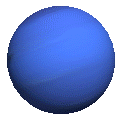


[For Background Music, Click "Play!" To Pause it, Click "Pause!"].
HISTORY


What Is Neptune
Neptune is the Eighth and farthest known planet from the Sun. It is the fourth-largest planet in the Solar System by diameter, the third-most-massive planet, and the densest giant planet. It is 17 times the mass of Earth. Compared to Uranus, its neighbouring ice giant, Neptune is slightly more massive, but denser and smaller. Being composed primarily of gases and liquids, it has no well-defined solid surface, and orbits the Sun once every 164.8 years at an orbital distance of 30.1 astronomical units (4.5 billion kilometres; 2.8 billion miles). It is named after the Roman god of the sea and has the astronomical symbol ♆, representing Neptune's trident.
Facts About Neptune
- Neptune is the most distant planet from the Sun..
- Neptune was not known to the ancients.
It is not visible to the naked eye and was first observed in 1846. Its position was determined using mathematical predictions. It was named after the Roman god of the sea.
- Neptune spins on its axis very rapidly.
Its equatorial clouds take 16 hours to make one rotation. This is because Neptune is not solid body.
- Neptune is the smallest of the ice giants.
Despite being smaller than Uranus, Neptune has a greater mass. Below its heavy atmosphere, Uranus is made of layers of hydrogen, helium, and methane gases. They enclose a layer of water, ammonia and methane ice. The inner core of the planet is made of rock.
- The atmosphere of Neptune is made of hydrogen and helium, with some methane.
The methane absorbs red light, which makes the planet appear a lovely blue. High, thin clouds drift in the upper atmosphere.